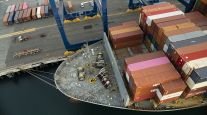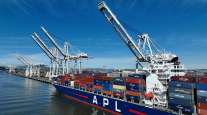Port’s Clean Trucks Program Cuts Emissions
This story appears in the June 14 print edition of Transport Topics.
Officials at the Port of Los Angeles are crediting their clean trucks program for significantly lowering diesel emissions in 2009.
The program, which has resulted in the significant turnover of older trucks to newer and cleaner models, reduced overall diesel particulate matter emissions by 37% from 2008 levels, nitrogen oxide emissions by 28% and sulfur oxide emissions by 36%, according to the port’s annual emissions inventory report.
“Even with recession-related cargo declines factored in, we saw very positive year-over-year emissions reductions in 2009,” Geraldine Knatz, the port’s executive director, said in a statement. “The results show that the investments the port and its customers have made in cleaner operations are delivering a healthy payoff.”
However, not all of the emissions reductions could be attributed to the newer trucks.
“The economic slowdown in 2009 with reduced throughput levels was a major factor in emission reductions,” the report concluded. “However, the rate of emission reductions in 2009 was higher than the change in activity level because of the emission reduction strategies implemented by the port, tenants and vessel operators in 2009.”
The port’s emissions report said heavy trucks contribute 25% of the port’s particulate-matter emissions, 38% of NOx emissions, 39% of carbon monoxide emissions and 39% of hydrocarbon emissions.
Comparing 2009 emissions with those in 2005, the reductions were more pronounced — a 52% drop in PM, 33% for NOx and 56% for SOx.
The report also supported port officials’ claims that the clean trucks program has changed the complexion of the drayage trucks operating at the port.
The percentage of 2007 model year and newer trucks increased to 16% in 2009 from about 4% in 2008, the report said. Officials have said they expect those numbers to increase significantly in 2010.
Because carriers are buying new trucks to avoid paying a $70 per 40-foot-equivalent container fee, the average age of the port-related truck fleet dropped to 10.9 years in 2009 from 12.1 years a year earlier. The report also showed that the newer trucks made proportionally more calls than their older counterparts.
The port study also measured emissions reductions by ocean-going vessels, largely because of tougher marine fuel regulations and a switch to low-sulfur fuels in their main and auxiliary engines when approaching the port or docked there. Emissions from locomotives also continued to decline, the report said.
Despite the encouraging trend, the report cautioned that as anticipated cargo volumes increase in upcoming years, reduction trends may not continue at the same rate experienced over the past few years.
“Continued implementation of several significant emission reduction programs, such as the port’s clean truck program, vessel speed reduction, alternative maritime power, and the California Air Resources Board’s regulatory strategies for port-related sources, is expected to substantially mitigate the impact of resumed cargo growth,” the study said.
The clean trucks plan at the ports of Los Angeles and Long Beach first went into effect in October 2008, when all pre-1989 trucks were banned. The second phase of the plan went into effect Jan. 1, when the ports banned all 1989-1993 model year trucks as well as 1994-2003 trucks not retrofitted.
“We’re definitely on track to meet . . . our long-term air quality goals,” Christopher Patton, acting assistant director of environmental management for the Port of Los Angeles, said in a statement. “In fact, in five years we’ve come more than halfway towards our 10-year target for PM and SOx emissions reductions, and we are striving to continue to exceed our target for NOx.”
Starcrest Consulting Group, an environmental consultant, compiled the report. A similar report for the neighboring Port of Long Beach was scheduled for release late last week.




